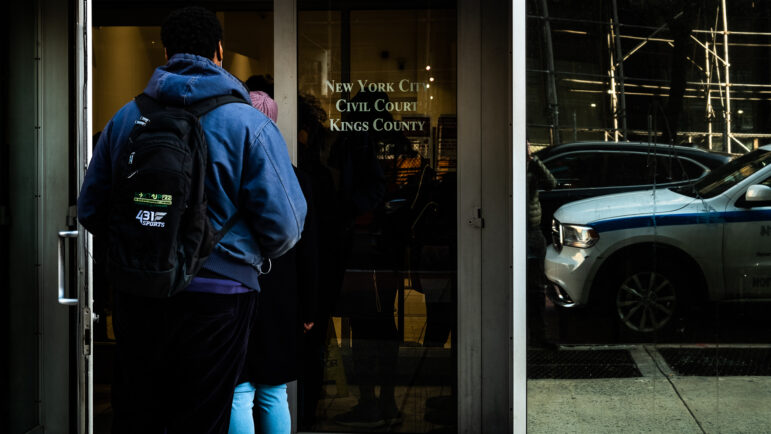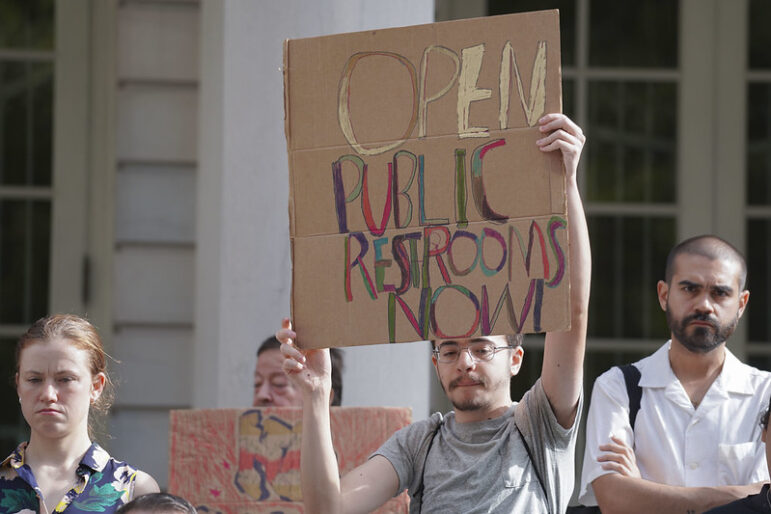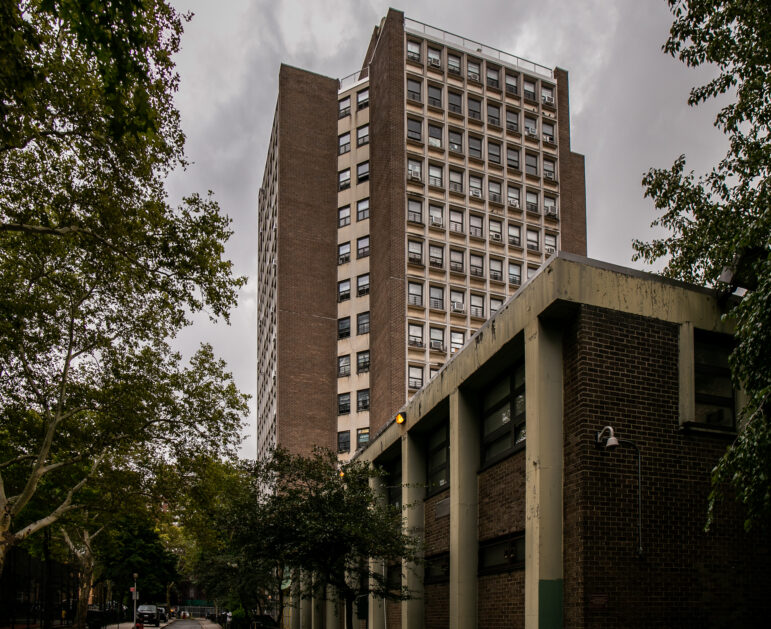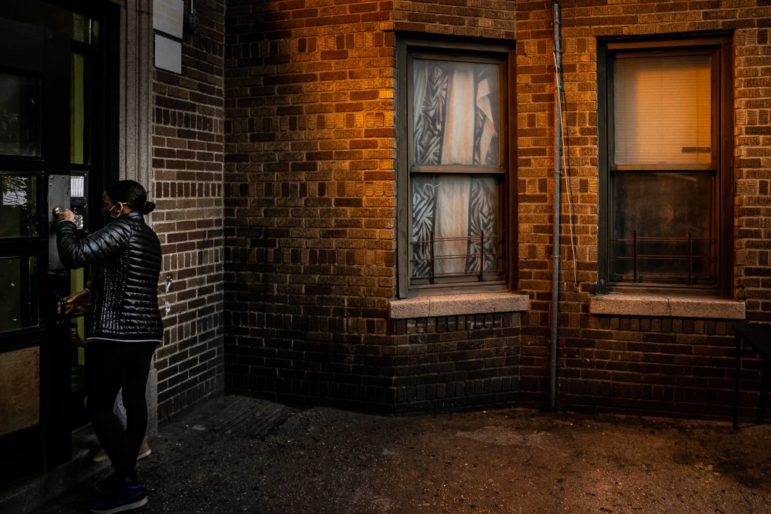
Adi Talwar
A construction site on the south corner of 41st Avenue
and 21st Street. Questions about how to balance industrial, office and residential uses are among the thorny issues in the LIC rezoning debate.
Long Island City knows all about rezonings.
There was the transformation of the waterfront from an industrial wasteland into a skyscraper mecca—a project that began during the Koch administration and continues to unfold with the development of 5,000 housing units at Hunters Point South.
There were multiple rezonings to transform inland neighborhoods, including Hunters Point, Queens Plaza and Dutch Kills, from manufacturing to “mixed use,” encouraging a mix of commercial and residential development.
And the de Blasio administration says there’s room for more. Long Island City is one of the seven neighborhoods the administration has publicly announced it will target for upzoning as part of its plan to build or preserve 200,000 units of affordable housing (the administration has since shelved its plan for Flushing, Queens). The neighborhood, notes the Department of City Planning (DCP) on its website, offers great transit access and proximity to both Manhattan and the emerging Cornell Tech campus on Roosevelt Island, making it an excellent spot for developing an “economically diverse, 24/7, mixed-use community.”
The Long Island City Core Neighborhood Planning Study area by and large overlaps with the 2001 Queens Plaza study area and parts of the 2008 Dutch Kills study area—land, in other words, that has already been rezoned for mixed use. DCP say those rezonings promoted high-density development next to subway corridors, but that other parts of those neighborhoods still have room for development. DCP’s study also includes a few blocks to the east and west of those previous rezoning areas, areas that remain designated for manufacturing.
Of all the announced rezoning neighborhoods, Long Island City has moved slowest: DCP has yet to conduct any public meetings. City planners say they are taking their time to craft an appropriate plan for the area, and in the upcoming weeks will meet with local Councilmember Jimmy Van Bramer to launch a strategy for public engagement.
Part of the process will be responding to issues that have arisen out of the Bloomberg-era zoning changes. Some residents, noting that development has exceeded the prior administration’s predictions, are wary about the impact of a second rezoning on the neighborhood’s infrastructure. Others are critical of the balance of new building types the previous rezonings produced, and see deficiencies in the amount of affordable housing, local hiring or good jobs that were generated. There are also complaints about the marginalization of public housing residents in the changing neighborhood.
Here’s what some stakeholders are saying about how previous rezonings went right and where they went wrong—and what they’re expecting from de Blasio’s efforts.
Catching up on infrastructure
In 2001, DCP predicted that the rezoning of Queens Plaza would lead to the creation of 300 housing units, five million square feet of office space and some new retail and institutional spaces. Based on those projections, the agency predicted that the area would see a large influx of workers and a small increase in residents. Its environmental impact statement concluded the rezoning would not necessitate new police facilities, firehouses or schools, but would impact parks and create pressures on traffic and transit.
Contrary to expectations, however, the rezoning spurred the development of 10,100 housing units, 1.5 million square feet of office space, and 600 hotel rooms, according to DCP. In the Queens Plaza census tract, according to census data, the residential population more than doubled between 2009 and 2014. The local development corporation Long Island City Partnership reports an additional 24,500 housing units on the way in larger Long Island City.
“The one thing that we didn’t anticipate … was the way the residential market took off so immediately. We imagined that it would actually produce more of an office component,” said DCP Queens director John Young at the 2015 Long Island City Partnership Summit.
Van Bramer, State Senator Michael Gianaris and members of community boards 1 and 2 expressed concern to City Limits about the impact of population growth on neighborhood infrastructure. Some cited the need for new FDNY and health facilities, while all complained of overcrowding in trains and schools. Van Bramer says between 2010 and 2015 he oversaw the financing and construction of six new schools—yet by 2015 Long Island City’s school district had become the 9th most overcrowded of the city’s 32 school districts, according to data from the Independent Budgeting Office.
Patrick O’Brien, chair of community board 2, is concerned about how another rezoning—without proper planning—might exasperate these trends.
“The notion of continuing to add significant numbers of housing, even if for the admirable purpose of creating affordable housing….it presents what is almost an insurmountable hurdle in the short run, and even in the long run,” he says.
The de Blasio administration has emphasized it intends to do a better job than past administrations at preparing for neighborhood growth, and DCP officials are well aware of Long Island City residents’ infrastructure concerns. The agency’s project web page notes that the agency is in the process of implementing recommendations from its 2014 Western Queens Transportation Study, which will include streetscaping, traffic improvements and updates to the area’s bus network and bike trails. The city also hopes to improve “regional connections” through the creation of the Brooklyn Queens Connector, a streetcar that will travel between Sunset Park and Astoria.
In addition, heeding Van Bramer’s call for more schools for Long Island City, this year the de Blasio administration committed to creating an additional four schools in District 30, including three schools for Long Island City and one in Woodside. An analysis by the School Construction Authority, which estimates future residential development in consultation with DCP and does take into account potential rezonings, projects that Long Island City will need 2,028 additional school seats in coming years, of which the current budget covers 1,800 seats. If that predicted growth is right, it would leave Long Island City in better stead that many other neighborhoods. The neighborhood’s future need, however, will greatly depend on the actual scale of the rezoning and ensuing residential development.
A better balance of mixed uses
On top of creating pressures on local infrastructure, past rezonings have led to some imbalances in commercial uses. According to a Long Island City Partnership brochure, retail development has not kept apace with residential growth, leading to unmet demand for a variety of retail services. Some stakeholders hope the rezoning will address that need.
Homeowners in Dutch Kills, meanwhile, are frustrated by another type of imbalance: an influx of hotels. And some, noting the city’s transformation of the Verve Hotel to a women’s shelter last October, are worried about a wave of hotel-to-shelter conversions.
“We wanted to see the same people walking their dog [every] day,” says Thea Romano, a member of community board 1 and president of the Dutch Kills Civic Association, who hopes the city will place limits on hotel development as well as a moratorium on new shelters.
Other neighborhood stakeholders are concerned about the decline of manufacturing businesses in the area. The city’s 2001 environmental impact statement said the city intended to rezone areas that had fewer active industrial uses, while allowing more active industrial corridors to continue thriving.
While it’s difficult to quantify the impact of zoning changes, manufacturing businesses have clearly taken a hit in and outside the rezoning area. While the total number of businesses in the 11101 ZIP code grew from 2,553 in 1998 to 2,866 in 2012, the number of manufacturing businesses decreased from 514 to 323 during the same time, according to an analysis by the Wall Street Journal.
The “mixed use” rezoning designation that has been applied to much of Long Island City technically allows industrial businesses to exist alongside residential and commercial buildings, but in practice, landlords often push out their industrial tenants to take advantage of the higher profits from residential or commercial development. In addition, those areas of Long Island City that remain designated for only manufacturing uses have seen an influx of hotel development and storage facilities, uses that are permitted in manufacturing areas.
“We’ve really seen an erosion of the industrial base in and around Long Island City,” says O’Brien. “None of these things are welcome developments…These people provide employment.”
O’Brien hopes the city’s rezoning study will find a way to preserve manufacturing businesses within mixed-use areas, and he want to see the city pass a law that would limit hotel construction in Industrial Business Zones (IBZs).
On the other hand, some would like to see the city expand the “mixed use” designation into one of Long Island City’s IBZs. Last year, the Urban Upbound Merchants Association, a coalition of small business owners organized by the anti-poverty nonprofit Urban Upbound, commissioned a study of Long Island City’s northwest side, which includes an IBZ that in recent years has seen a proliferation of low-budget hotels. Their final report includes a diversity of strategies to revitalize the area, including rezoning the neighborhood to a mixed-use district. The report also emphasizes the importance of manufacturing jobs and recommends the zoning district require manufacturing uses on ground floors and special permits for hotels.
“This is Long Island city now. This is not Long Island City of [yesterday],” says Urban Upbound’s executive director Bishop Mitchell Taylor, who believes loosening the IBZ restriction could create new opportunities for neighborhood residents.
It is unlikely, however, that the administration would consider rezoning an IBZ. In November, Mayor de Blasio and Speaker Melissa Mark-Viverito proposed a suite of policies to strengthen the industrial sector, and explained that the administration would no longer look favorably on conversions of IBZ properties to residential. In addition, the city plans to require special permits for hotels and self-storage facilities in Industrial Business Zone, a policy change that will likely undergo public review this fall.
DCP officials told City Limits that in Long Island City they hope to foster an appropriate balance of retail, office space and industrial uses in the area. They will consider various land-use tools including regulation of ground-floor uses, increasing density for specific uses and new strategies emerging from their current study of the North Brooklyn Industrial Business Zone.
Real affordability for all (literally)
In DCP’s 2001 environmental impact statement, the agency predicted there would be no direct or indirect displacement of residents within 10 years. Yet the wider 11101 ZIP code has undergone some demographic shifts: Since 2000, the presence of black residents in the 11101 zip code fell from 25.2 percent of the total population to 18.2 percent, while the number of white residents climbed from 39.5 percent to 48.9 percent. Median income, meanwhile, increased from about $29,000 to $49,000.
It’s hard to know how much rising rents or shifting demographics were triggered by prior rezonings, but it is inarguable that past rezonings did little to mitigate displacement, creating only a small amount of new affordable units. The 2009 Dutch Kills rezoning established a voluntary inclusionary housing zone, where developers were offered extra density if they provide affordable units. But that program has never produced a single unit of affordable housing.
There will be more affordable housing at Hunters Point South, a development project currently underway on the southwest side of Long Island City’s waterfront. The city says it will ensure that 60 percent of the project’s 5,000 new units are rented at below-market rates. Yet most of the Hunters Point South buildings developed so far are not affordable to low-income residents. The vast majority of “affordable” units in buildings that have been completed or are already under construction have been rented to households with moderate or middle incomes—between 105 percent and 230 percent AMI, or $81,585 and $178,710 for a family of three.
“We have heard the word ‘affordability’ a lot. The fact is, it’s not affordable,” says Mary McClary, a member of the Justice for All Coalition, an alliance of about a dozen labor, church, and public housing tenant organizations that is organizing the Western Queens community to demand good jobs and affordable housing in response to the city’s potential rezoning.
Affordable housing development is one of the de Blasio administration’s central goals for Long Island City. The administration hopes to tap the neighborhood’s thriving residential market to create affordable units using the city’s new mandatory inclusionary housing policy.
Gianaris says it’s crucial that a new rezoning provide affordable housing at a mix of income levels—and not only housing: He’d like to see the city fund nonprofits to establish affordable business incubator spaces where graduates of Cornell Tech and others can launch technology start-ups.
Dutch Kill homeowners, burdened by rising property taxes, also want the city to mitigate their housing costs. They are hoping DCP will expand its current rezoning study area a few blocks west and rezone their blocks to higher densities, giving them the ability to build up their own properties and take on tenants.
And artists want some attention too. Carol Crawford, board president of Long Island City Artists, hopes the city will invest in affordable work spaces for artists and assist her organization establish a new headquarters where local artists can hold exhibitions and classes. The organization lost its former headquarters, at a former Paper Factory on Northern Boulevard, when the property owner sold to a hotel developer.
Van Bramer shares her concern.
“Long Island City has long been a haven for artists, and we can’t lose the character that makes the neighborhood one of the most vibrant in the city,” he said in an e-mail to City Limits.
A role for Queensbridge Houses
Queensbridge Houses is the city’s—and nation’s—largest public housing complex, with roughly 7,000 residents. The complex, which sits in the IBZ on the northwest side of Long Island City, has sat outside of Long Island City’s prior rezoning boundaries.
McClary, a resident of another NYCHA development nearby, says that the rezonings to the south and east have made the surrounding areas safer and greener. Yet it’s also brought challenges for NYCHA residents, including a loss of parking and rising retail prices.
“While its beautiful, and the expectations for the change are great…a lot of us are feeling not a part of [it],” says McClary. “We don’t feel connected to this change.” She added that she was eager to know how future rezoning would affect NYCHA developments like Queensbridge Houses. “It can’t remain the same in the midst of opulence.”
The perimeters of DCP’s current study get closer to Queensbridge, including two blocks across the street from the NYCHA complex that remain zoned for manufacturing (but are not part of the IBZ). Those two blocks are home to a construction site where a developer will construct a 9-story hotel, and an arts storage facility owned by UOVO. McClary would like to see that land used to meet the needs of Queensbridge Houses residents, such as for low-income housing or a quality and affordable supermarket.
One of DCP’s main intentions for their future rezoning of Long Island City is “integrating Queensbridge Houses into the larger Long Island City neighborhood.” DCP hopes to extend bike paths and streetscaping improvements to Queensbridge Houses, as well as craft a workforce development plan to help its residents take advantage of emerging job opportunities.
Taylor of Urban Upbound says his organization has managed to place “some, but not enough” of public housing residents ino jobs created by prior Long Island City rezonings, and that he’d like to see the government strengthen its regulations that require developers receiving government subsidies to participate in local hiring programs.
De Blasio has already made efforts to strengthen such programs. In October he launched HireNYC, expanding the number of projects and agencies that require the use of Workforce1. But Bernard Callegari, a former Queensbridge Houses resident and a field representative at the Greater New York Laborers-Employers Cooperation and Education Trust, would like to see those programs expanded further. He argues that when a developer receives a contract or public financing, the city should ensure local workers receive opportunities to enter apprenticeship program that lead to safe, union jobs on the developer’s site. As part of its compliance with HUD regulations, the city already provides such opportunities for development sites in the Hurricane Sandy Build It Back program.
“The rezonings that took place in Long Island City in many ways…benefited the developer,” Callegari says. “I hope that this rezoning benefits the people currently [here] as well.”
City Limits’ coverage of housing issues is supported by the Charles H. Revson Foundation and the New York Community Trust.








